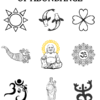Balance lies at the heart of existence.
It’s the harmonious balance between the four elements, the material and spiritual, form and the formless, day and night, masculine and feminine, and many other dualities that form the basis of our existence.
The principle of correspondence, often summarized as “As above, so below,” suggests that the microcosm reflects the macrocosm, and vice versa. This means the grand designs of the universe reflect within us. Thus, we also need to bring balance and harmony within our own being in order to lead a life of peace, happiness, and fulfillment.
If you wish to bring balance into your life, meditating on symbols can be hugely beneficial. In this article, let’s look at 34 powerful symbols of balance and harmony. These symbols can serve as guides, helping you embrace harmony and completeness in your life. So let’s begin.
34 Symbols that Represent Balance and Harmony

1. Yin-Yang

The Yin-Yang is an ancient Taoist symbol of balance and harmony.
It is drawn as a circle split into two teardrop-shaped halves: one black (representing Yin or feminine energy) and one white (symbolizing Yang or masculine energy). What’s interesting to note is that each half contains a small circle of the opposite color, signifying the idea that within each force exists an element of its opposite.
Thus the masculine contains the feminine and the feminine contains the masculine suggesting the perfect balance, harmony, interconnectedness, and interdependence of opposites.
2. 6-Pointed Star (Hexagram)

Just like the Yin-Yang, the Six-Pointed star (hexagram) is an ancient symbol related to balance and harmony. It consists of two overlapped equilateral triangles, one facing upward and the other facing downward. The upward-facing triangle represents the Divine Masculine (material realm) and the downward-facing triangle represents the Divine feminine (spiritual realm). Their overlapping indicates the perfect balance that exists between two opposing polarities which is the basis of all creation. The center of the star represents the source or consciousness from where creation happens.
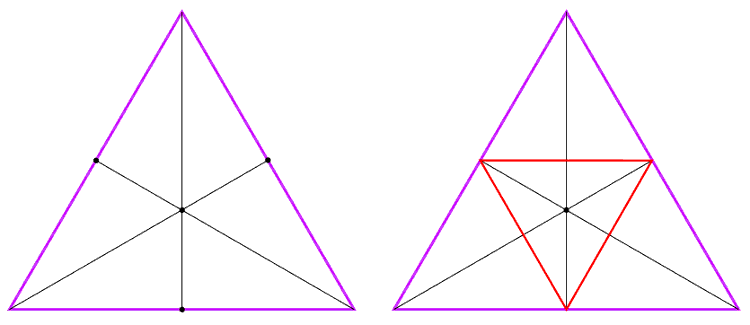
Interestingly, just like the Yin Yang, if we were to connect the central points of all three sides of one triangle, we get a smaller equilateral triangle facing in the opposite direction within the larger triangle (as shown in the image above). This represents the presence of one polarity within the other just like the Yin-yang. When we join these triangles now, we get the following image that contains a smaller hexagram within the larger hexagram mimicking the Yin-Yang.

The Six-Pointed Star also signifies the balance and harmony that exists between the four basic elements – Fire, Air, Earth, and Water. Out of these, Fire and Air are considered masculine in nature represented by upward-facing triangles while Earth and Water are feminine in nature represented by downward-facing triangles.

The center of the star represents the 5th element which is spirit or ether that is present within all four elements.
Thus the six-pointed star is a symbol of balance between a person’s groundedness, fire (passion), flow, and airiness. It urges you to harmonize both the spiritual and material facets of your life, as well as to balance the four elements within you.
3. Unicursal Hexagram

The standard hexagram, as previously mentioned, is comprised of two overlapping triangles and cannot be drawn in a single movement. In contrast, the unicursal hexagram can be drawn with a single, contineous line (without the need to lift the pen).
The symmetrical design of the unicursal hexagram, coupled with its continuous formation, symbolizes balance, harmony, unity, interconnectedness, and the concept of infinity.
4. Vesica Piscis
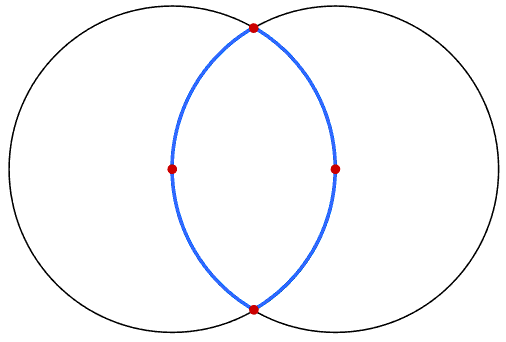
The Vesica Piscis is a fundamental Sacred Geometry symbol consisting of two overlapping circles.
The circles overlap in such a way that the circumference of one circle runs through the center of the other. The lens shape formed by these overlapping circles is called the Vesica Piscis (also known as the Mandorla).
Just like the Yin-Yang, the Vesica Piscis represents the perfect balance that exists between the spirit and material realms or two opposing forces/energies. The circle on the left represents the spirit realm (feminine energy) and the circle on the right represents the material realm (masculine energy). The Vesica Piscis (Mandorla) formed by their intersection represents the source of all creation.

Interestingly, each circle of the Vesica Piscis contains a Six-Pointed Star and the stars overlap in the center and form another smaller star within the Mandorla as shown in the image above.
5. Seed of Life

The Seed of Life is a powerful sacred geometry symbol that is created by adding five more circles to the Vesica Piscis (as discussed above). Thus the Seed of Life contains a total of 7 circles, one circle in the center, surrounded by 6 overlapping circles.
The circle in the center symbolizes the spirit or source energy that connects all other circles. It represents balance, unity, interdependence, and interconnectivity. Also, the symmetrical pattern of the Seed of Life further conveys balance and harmony. The 7 circles together also represent the 7 days of creation.
Interestingly, the Seed of Life contains both the Yin-Yang and the Six-Pointed Star within it.
The following image depicts the Yin-Yang symbol within the Seed of Life.
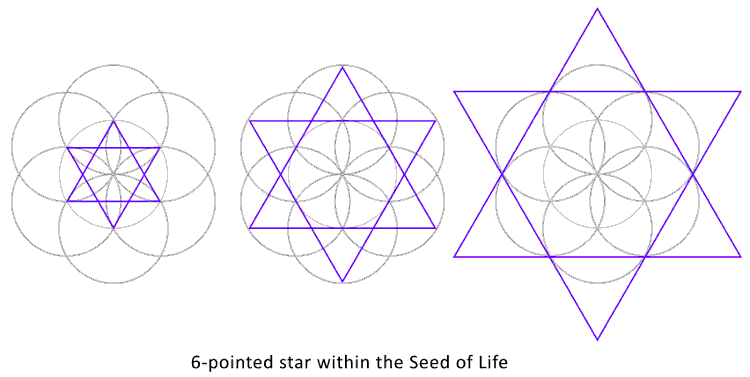
The following image depicts three instances of the Six-Pointed Star symbol within the Seed of Life.

There are many more symbols that can be formed out of the Seed of Life that also represents balance and harmony. These include the Flower of Life, the Egg of Life, Lotus of Life, Torus, the Fruit of Life, Metatron’s Cube, and the Platonic Solids.
6. Merkabah
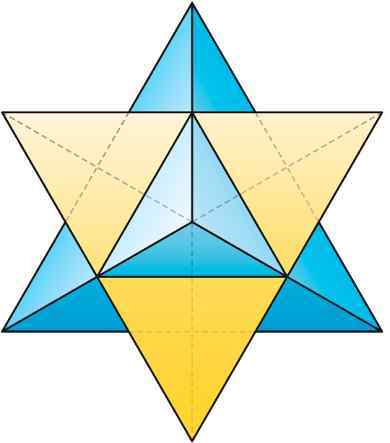
The Merkabah is the 3D representation of the Six-Pointed Star. It consists of two overlapped tetrahedrons, the top one rotating clockwise and the bottom one rotating anti-clockwise.
Merkabah is a Hebrew word that can be broken down as follows:
- Mer: Light
- Ka: Spirit
- Bah: Body
Hence, Merkabah literally means the Body and Spirit surrounded by light. The upper tetrahedron represents Spirit, whereas the lower one represents the Body. Their perfect union creates the light of life or creation. Thus the Merkabah is a powerful symbol representing balance and harmony.
7. Platonic Solids

The Platonic solids are unique geometric shapes that symbolize balance and harmony. These five distinct solids are the Hexahedron (cube), Tetrahedron (triangular pyramid), Octahedron (double pyramid), Dodecahedron, and Icosahedron.
Their uniqueness stems from three key characteristics as follow:
- All faces of the platonic solids are of the same shape and size.
- Every vertex or corner in each solid is identical.
- Each solid can fit perfectly inside a sphere with all vertices touching the sphere’s surface.
For instance,
- The Tetrahedron has 4 triangular faces with 3 triangles meeting at each vertex.
- The Hexahedron, or Cube, has 6 square faces with 3 squares meeting at each vertex.
- The Octahedron comprises 8 triangular faces with 4 triangles uniting at each vertex.
- The Dodecahedron has 12 pentagonal faces, and 3 of them come together at each vertex.
- The Icosahedron possesses 20 triangular faces with 5 triangles meeting at each vertex.
The platonic solids also represent the five elements (as depicted in the image above). Due to their distinct features, they are perfect representations of balance and harmony.
8. Octahedron

Of all the platonic solids, the Octahedron is extra special. It’s formed by two square-based pyramids (Pentahedrons) connected at their bases. The shared square base symbolizes the four elements: Fire, Air, Earth, and Water.
The upper pyramid represents the Spiritual Realm and the lower one represents the Material realm. The center of the Octahedron represents Source energy. Thus the Octahedron represents the balance that exists between the spiritual and material realms and between Spirit/Source energy and the 4 elements of the material world.
9. Lakota Triangle
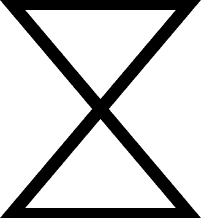
The Lakota is a 2D representation of the Octahedron symbol (as discussed above). It is an ancient Native American symbol that represents the balance and connection that exists between the sky or the heavens (spirit realm) with the Earth (material realm). Thus Lakota is a symbol of balance, unity, and interconnectedness.
10. Celtic Cross
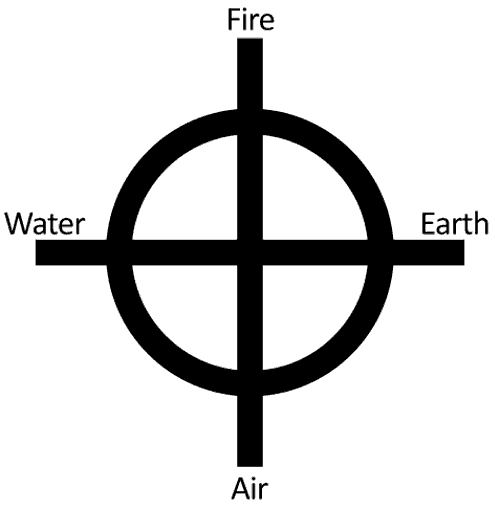
The Celtic Cross features a vertical and a horizontal line of equal length, intersecting at the center forming a cross sign. It is enclosed by a circle symbolizing eternity or life’s cyclical nature.
The horizontal line represents the divine feminine or spiritual realm. It also represents the feminine elements of Water and Earth. The vertical line on the other hand represents the divine masculine or material realm and the elements of Fire and Air. Their point of intersection represents the spirit or source energy.
Therefore, the Celtic Cross symbolizes the harmony of the four elements and the equilibrium between the material and spiritual worlds.
11. Eight-Pointed Star

In Hinduism, the eight-pointed star, formed by two overlapping squares, represents Lakshmi, the Goddess of Wealth and Abundance. It symbolizes the balance between the eight forms of wealth as follows:
- Adi Lakshmi: Wealth of Courage and Strength.
- Dhana Lakshmi: Wealth of Money and Gold.
- Dhanya Lakshmi: Wealth of Food and Grain.
- Gaja Lakshmi: Wealth of Power and Sovereignty.
- Santana Lakshmi: Wealth of Lineage and Offspring.
- Veera Lakshmi: Wealth of Bravery and Victory in Battles.
- Vidya Lakshmi: Wealth of Knowledge and Education.
- Vijaya Lakshmi: Wealth of Success and Achievements.
In Hinduism, balance between these forms of wealth is said to help one lead a happy and fulfilling life.
12. Squared Circle
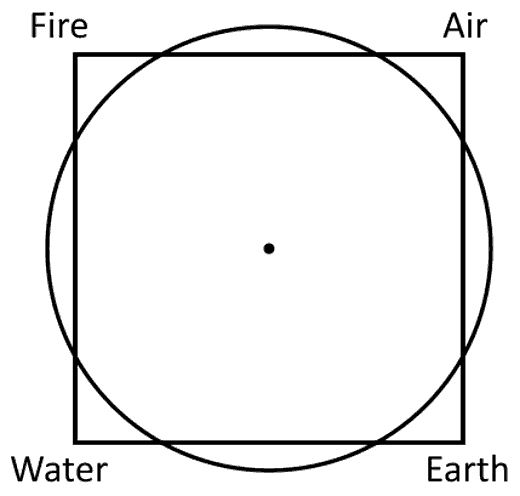
The Square usually represents the material realm and the four corners represent the four elements of the material realm – Fire, Air, Water, and Earth. In contrast, a squared circle signifies the harmonious and interdependent relationships among these elements. The circle also represents the 5th element – spirit/ether/source and the cyclic nature of existence.
13. Celtic Five-Fold Knot

Similar to the Squared Circle, the four outer circles of the Celtic five-fold knot symbolize the four elements. The central circle, linking the four elements, embodies the spirit, universe, or source energy. Collectively, these five circles signify the balance and interconnection of the elements and all things in nature.

Interestingly, the Five-Fold knot also contains within it the Yin-Yang symbol as depicted above.
14. Tree of Life

Illustrated as a giant tree, with branches reaching skyward and roots trailing downward, the Tree of Life is a symbol that signifies the balance between grounding and growing. To explain: if we always “ground”, or grip tightly onto our material desires, we’ll never grow. However, if we always strive to grow and grow and grow, we’ll never feel like we’re good enough, and we’ll never feel grounded.
15. Twin Koi Fish
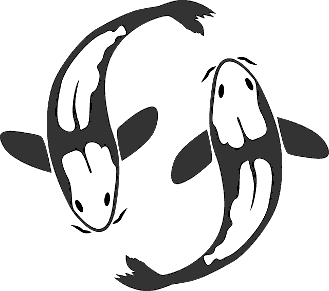
Often, you’ll see the Yin-Yang symbol depicted as a black and a white koi fish aligned with each other, head-to-tail and vice versa. It’s said that these depict a female and a male koi fish. This symbol represents the balance and harmony of opposites, such as masculine/feminine, light/dark, and life/death.
16. Moon

The moon has represented femininity and, in turn, balance, in countless world cultures. Due to her consistent, cyclical nature, the moon shows us that it’s okay to go through periods of bright fullness followed by dark hibernation.
17. Double Spiral

The double spiral is an ancient spiral symbol that represents opposing forces; it brings to mind the sun (or any star), with its outward push of energy balanced with its massive inward gravitational pull. To relate this to human life, you can think of the double spiral as representing the balance between your need to “do”, and your need to rest, just to name one example.
18. Circle

Humans have long seen the circle as the most perfect shape, and as such, it has inspired countless spiritual symbols. Some examples include the Yin-Yang, the Enso, and the Seed of Life. In many of these spiritual traditions, circles such as the Enso exemplify the oneness and interconnectedness of the entire Universe, inherently representing life’s great harmony.
19. Endless Knot

Found scattered across religions such as Hinduism, Buddhism, and Jainism, the Endless Knot helps us to remember that everything is connected. We may feel that we are separate from other human beings, but we’re all one. This keeps us in balance and harmony: it reminds us that if we do something to hurt another, we hurt ourselves, and when we hurt ourselves, we hurt others.
20. Dharma Chakra

Symbolizing the concept of “dharma”, or perfect order, this symbol is essential to Hinduism, Buddhism, and Jainism. The turning of the wheel tells us that everything in the Universe comes and goes like clockwork. Everything is in harmony, whether it seems that way or not.
21. Cosmos flower
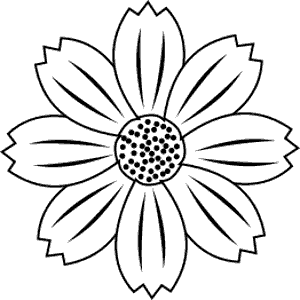
Looking at a bright cosmos flower, you’ll notice how symmetrical its perfectly-aligned petals are. Due to their orderliness, they were named the “cosmos” flower, as they were said to represent the perfect order and harmony of the entire Universe.
22. Number 2

If you’re like me, you may often see repeating numbers on license plates and receipts and such– and “222” is one of my favorites! In this context, the number 2 is telling you to search for balance within you. Can you strive for more balance between work and rest, masculine and feminine, introversion and extroversion?
23. Equilateral Triangle

The equilateral triangle, with sides and angles that are all exactly the same, represents the harmony of body, mind, and spirit. This symbol shows us that if all three– body, mind, and spirit– are checked and balanced, with no one overpowering the other two, only then can we live a harmonious life.
24. Zebra

Such a unique animal as the zebra almost reminds one of a living, breathing Yin-Yang symbol, with its striking juxtaposition of black and white. This animal reminds us that polar opposites can, in fact, exist in perfect harmony together.
25. Beaver

Beavers are the hard workers of the animal kingdom. We admire their instincts which tell them to build a sturdy dam, and yet– beavers’ instincts also tell them when to take a rest, as well. So, beavers convey a sense of balance between work, play, and rest.
26. Rose

Roses are a symbol of balance due to their thorns – every rose indeed has its thorn! For example, we love our pets dearly, yet we adopt them with the knowledge that we will likely outlive them and have to say goodbye one day. Life is the rose, while death is the thorn; together, life and death are balanced and in harmony.
27. Bonsai trees

No list of symbols representing harmony is complete with the Bonsai tree, which is literally known as the “tree of harmony” in several Asian cultures. When someone gifts you a Bonsai tree, the gifter is telling you: “may you be whole and at peace”.
28. Trillium flower

Also known as the great white trillium, these flowers carry powerful, auspicious symbolism– and one of their symbolic meanings is, of course, spiritual balance. Since trillium flowers are so fragile, growing or admiring trillium reminds us to relax our emotional guard and let down our walls where possible.
29. Lucky bamboo

Have you ever been gifted a “lucky bamboo”, which looks like short stalks of bamboo in a houseplant-sized pot? Did you know that the number of stalks of bamboo in the pot can clue you in on the plant’s meaning? In fact, five stalks of lucky bamboo is said to represent balance and harmony, so search out this specific houseplant if you’re feeling unbalanced lately!
30. Peridot crystal

Those born in August know the peridot crystal as their birthstone. With a lighter hue than that of the emerald, peridot is said to balance one’s emotions. Thus, you might wear a peridot crystal if you find your moods to be a bit of a rollercoaster.
31. Ganesha

In Hinduism, Ganesha (or Ganesh) is the powerful elephant-headed deity who is said to remove obstacles from one’s lives. One of these obstacles can be our attachment to materialism. Thus, as a symbol of harmony, Ganesha helps us to attain balance between the material and the spiritual.
32. Flamingo

If you’ve ever seen a flamingo at the zoo, you know exactly why flamingos are a symbol of balance; it’s quite literal! Their awe-inspiring ability to balance on one leg– while resting, at that!– conveys a vibration of absolute centeredness.
33. Sunflower

If you look at the center of a sunflower closely, you’ll notice that its seeds follow a perfectly symmetrical spiral shape, called the “fibonacci spiral”. Nature’s perfect harmony created this iconic shape, without any help from man or machine. It follows that sunflowers (and the fibonacci spiral) can represent balance and harmony.
34. Ouroboros

Ouroboros is a popular symbol that depicts a serpent eating its own tail. This is symbolic of the perfect balance between creation and destruction that exists within the universe. It shows that life consumes life and as it consumes it continues to regenerate keeping the cycle active.
In Conclusion
The Universe– and Life– are always in balance and harmony, whether we know it or not. As such, the forces within you (such as the masculine-feminine energies) desire to be in balance, as well. When you’re not in balance and harmony, you may feel tired, antsy, anxious, irritable, or even depressed– but keep in mind that these spiritual symbols can inspire you to get back into balance. If one resonates with you, hang a picture of it on your wall or wear it as jewelry, and always remind yourself that the Universe exists in harmony!




